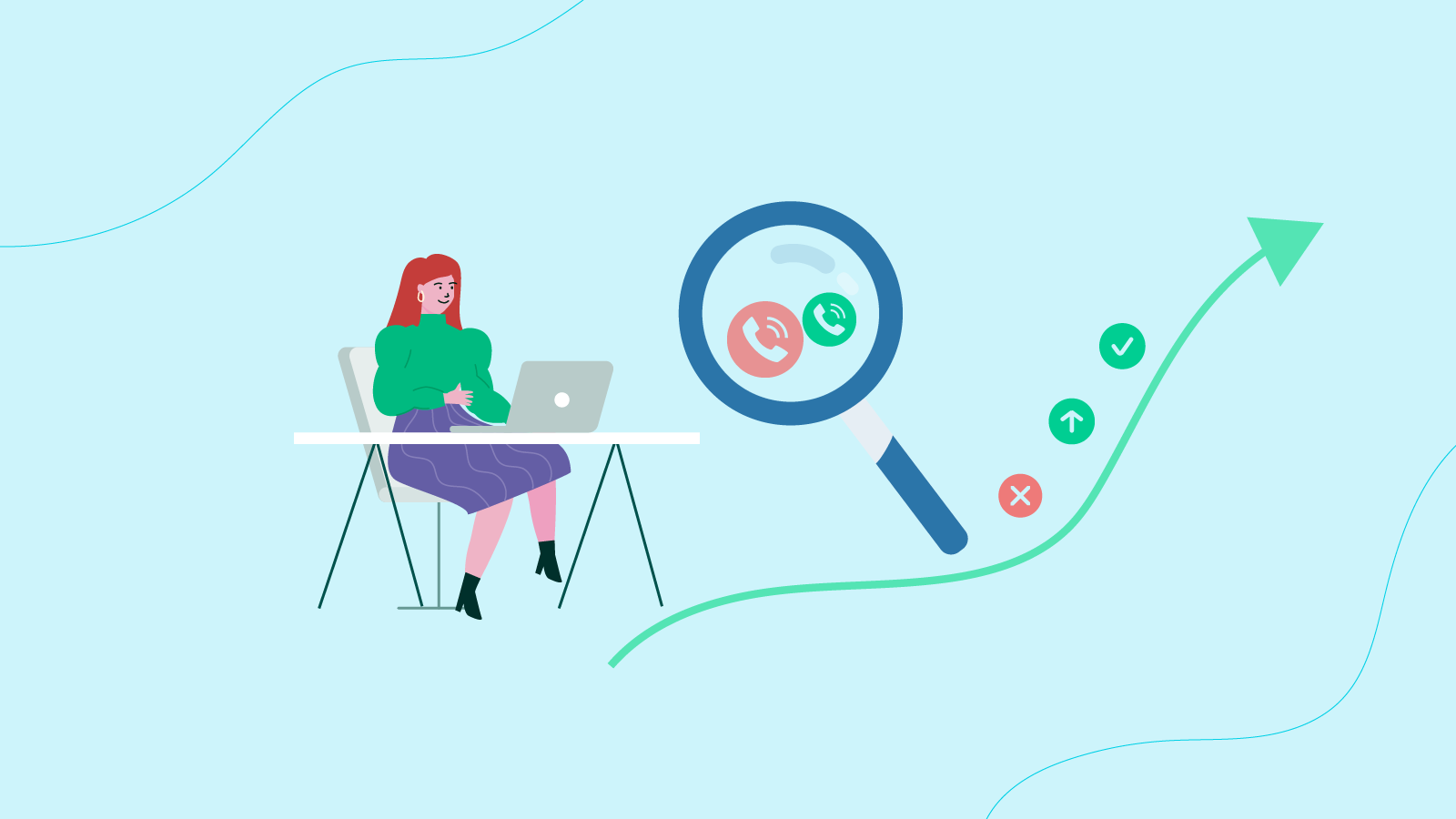How To Identify And Address Call Avoidance
When it comes to call avoidance (or, more accurately these days, interaction avoidance), you usually know it when you see it. Unless you don’t.
It’s easier than you think to misjudge an agent in an interaction, so I’ve assembled examples of interaction avoidance along with actions you should take when it occurs. We’ll also look at instances that are actually legitimate issues that an agent shouldn’t be penalized for.

Call Avoidance Examples And How To Spot It
During my tenure as a WFM professional, I would occasionally audit the agents, and, if the agent passed with no indicators of avoidance, I would give a “Kudos” to the agent and the supervisor. Typically, this would say, “During an audit of your interactions, there was no avoidance detected. Great job in servicing our customers. Kudos!”
If the agent didn’t pass, I would send my findings, along with all applicable reporting, to their supervisor as feedback for the agent. In this situation, I’d say, “During an audit of your agent’s interactions, there was avoidance detected. Please find all supporting documentation and provide feedback to the agent.”
Not only did these audits assist managers in spotting avoidance techniques and behaviors, but they also allowed the agents that were diligently working to get the praise they may not have received otherwise. I recommend adopting a similar auditing practice in your contact center to make sure you stay a step ahead of avoidance issues.
When you do, it’s helpful to know what to look for. Take a look at these examples of avoidance strategies by agents and what you can do about them.
Example: Logging into the system and then immediately going to a “not-ready code” to prevent any interactions from coming through.
Action: Review adherence and activity reports for any non-productive code usage at the start of their shift.
Example: Ending the customer interaction before greeting or resolution.
Action: Review reports for agent release. The agent will typically show a shorter handle time than their peers.
Example: Transferring a customer back into the queue, to another department, or to another agent unnecessarily.
Actions: Review the number of transfers in an interaction. Review short handle times or average handle time. The agent will typically show a shorter handle time than their peers.
Example: Placing a customer on hold or mute until he/she disconnects from the call or chat.
Actions: Review hold time reports. Review interaction handle time. The agent will typically show a shorter handle time than their peers.
Example: Switching codes rapidly within a few seconds to put themselves at the back of the line for the next interaction.
Actions: Review adherence and activity reports to determine if the agent is using unauthorized transactions. The agent’s interaction count will typically be less than their peers.
Example: Agents claiming IT issues with their systems so they’re unable to work.
Actions: Ask for the ticket number where the issue has been reported. If IT does not use a ticketing system, ask IT for a log of issues to determine if the agent has reported an issue. Have the agent show a manager what the issue is that is preventing them from working productively and attempt to troubleshoot for resolution.
Example: Staying in post-interaction status toward the end of the shift to avoid any further interactions.
Actions: Review any recordings or transcripts from the last interaction of the day. Review adherence for trends of this behavior.bReview hold or queue wait times at the end of the shift/day.
Example: Calling their own phone, family, or friends or handling personal issues when making outbound calls.
Action: Review telephony reports for numbers dialed and cross-reference the numbers on Google.
Example: Taking unnecessary, unauthorized, or excessive breaks.
Action: This is a tricky one. If you feel this is an issue, have a conversation with the agent. This could be a call/interaction avoidance issue, or it could be a health-related issue that the agent does not realize can be accommodated.
Related Article: Why Your Contact Center Needs A Call Avoidance Policy
Reasons For Call Avoidance
Not all cases are the same, and not all are black and white. Always check reports and recordings where available and applicable. Sometimes, what appears to be call avoidance or interaction avoidance can be a legitimate issue. Examples include:
“I work at home, and I heard the tornado sirens. I immediately took shelter. I failed to log out of the system properly, which caused me to sit in an idle status for a long period of time. I was accused of interaction avoidance and fired.”
“I needed help with an interaction, so I put the customer on mute and asked my coworker a question. My manager saw, and I was suspended for putting a customer on hold unnecessarily.”
“I was helping a customer who called in several times before for the same issue. I needed to transfer her to tech support and decided to stay on the line while they helped her. It was a complex issue, and I wanted to make sure it got resolved this time around. My manager saw how long I was on the three-way conversation and fired me for interaction avoidance.”
Sometimes agents do avoid interactions, but it’s for an understandable reason: burnout. Dealing with angry customers all day can be very draining for agents. Gallup reports that 76% of employees say they experience burnout at least some of the time. Employees who frequently experience burnout are 2.6 times as likely to be looking for a new job.
Agent attrition is costly and damages customer experience, so it’s best to find ways to ease stress for your team. Give agents a chance to explain why they’re avoiding calls or other interactions. The empathy you show by seeking out their side will help boost employee engagement and retention.
Related Article: 5 Proven Strategies To Help Remote Contact Center Agents Feel Valued
How To Address Call Avoidance
Proper research and investigation must be done before approaching the agent regarding suspected avoidance behavior. Steps include:
- Solve for the root cause
- Pull adherence, productivity/occupancy reports, and quality recordings
- Analyze findings and search for a pattern of avoidance
- Once reports are compiled and call avoidance has been shown, allow the agent to tell their side of the story
- Ensure the agent understands how interaction avoidance impacts customer satisfaction
- Clearly explain any disciplinary actions involved
Related Article: The Human Side of Workforce Management
Interaction Avoidance Action Plan
Creating the right interaction avoidance policy isn’t all about punishment. It’s about designing a set of guidelines that takes into account the causes of avoidance and clearly lays out the proper definitions, examples, and consequences. When everyone is clear on what call avoidance is, it’s easier for agents to follow and customer support center leaders to enforce.
Ensure all agents are aware of, understand, and acknowledge the call/interaction avoidance policy, and applicable disciplinary actions involved.
Related Article: Five Coaching Tips For Contact Center Agents that Work
Interaction Avoidance Disciplinary Letter
DISCLAIMER AND LEGAL INFORMATION: The information herein is NOT LEGAL ADVICE. The opinions expressed in this post represent only the opinions of the authors and are in NO WAY INTENDED AS LEGAL ADVICE upon which you should rely.
When presenting a disciplinary action to an agent regarding call/interaction avoidance, you will need to use all your research. Include dates, times, and other details to solidify your action. Be mindful of any privacy laws that would not allow you to include more information than absolutely necessary.
Clearly specify the course of action for those who avoid calls or interactions. This could include additional training, a warning, probation, and/or termination. All courses of action should be clearly defined to ensure understanding not only by the agent but also by their manager, guaranteeing consistency and fairness to all agents. See below example of an avoidance letter:
Date: ________________
Name of Agent: ________________
Subject: Warning for not answering calls/interactions
Dear (name of the employee),
During the course of an audit, it has come to our attention you have been avoiding (work type such as chats, emails, calls).
As stated in our Call/Interaction Avoidance Policy, (insert policy information and penalties for the issue).
Please consider this letter as a formal warning being issued to you for not answering customers’ (work type such as chats, emails, or phone calls), causing them inconvenience. Note that the company is under no obligation to tolerate negligence of the employee. Therefore, you are being notified that repetitive negligence like this will not be acceptable. Our next step is to (insert action here).
Please reach out to your manager or to Human Resources regarding any questions.
Yours sincerely,
(Signature of the sender)
Create A Contact Avoidance Policy
A well-thought-out call/interaction avoidance policy will not only make sure all agents are handling their workloads correctly, but it will also ensure you create accurate forecasts, which in turn saves your company money. Create a policy that helps everyone understand what call avoidance or interaction avoidance is and how it will be dealt with.Want to dig deeper into what makes a solid contact avoidance policy? Get our new free ebook, Combatting Contact Avoidance And Creating The Right Policy To Manage It.






